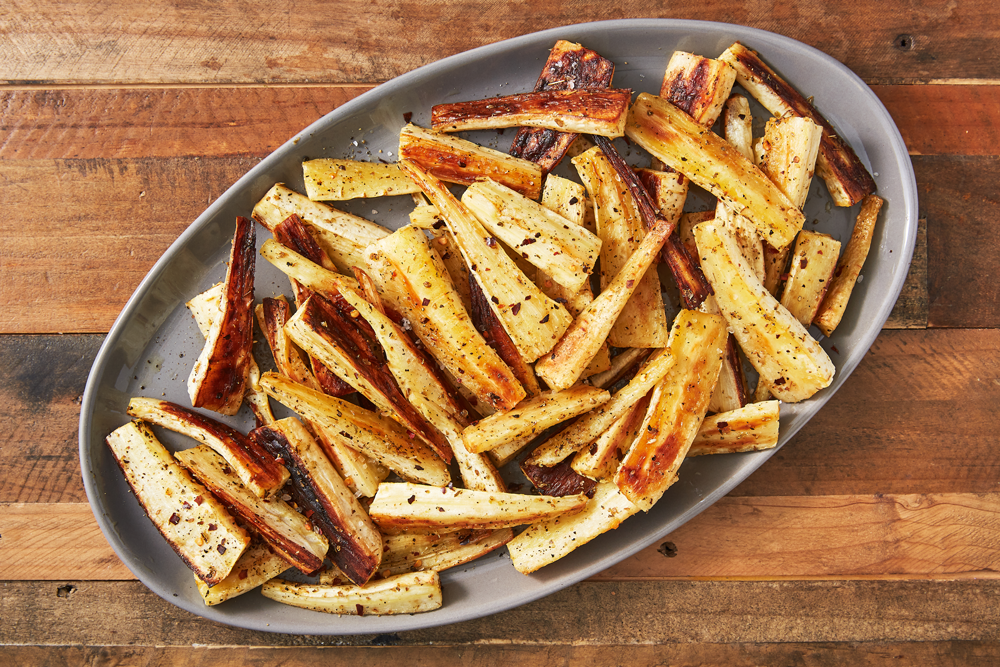
Cook for 30-40 minutes at 425 F, turning once, until softened. In a roasting pan or on a lightly oiled baking sheet, place parsnip slices or cubes. If purée is too thick or lumpy, add a very small amount of the cooking liquid and process again until smooth. In a blender or food processor, carefully place the cooked parsnips.

Puréeingīoil, microwave or steam parsnips until very tender. Cook on high until tender, about 4 to 6 minutes. Cover with a lid or plastic wrap that has a few holes poked in it for steam to escape. MicrowavingĬut parsnips into large chunks the same size and place in a microwaveable dish with about 2 tablespoons of water. Cook about 5 to 15 minutes or until tender. Drop whole or cut-up parsnips into the water and simmer until tender. Boilingīring a saucepan of salted water to a boil. Cook for 20 to 30 minutes in a 350ÌŠF oven. For savory results, season with broth and herbs and for sweet, cook as you would sweet potatoes, with orange juice, brown sugar, ginger and nutmeg. Put whole or cubed parsnips in a covered baking dish. FYI: 1 pound parsnips = 4 servings 1 pound = 4 to 6 small parsnips 1 pound = 2-1/2 cups diced, cooked parsnips Baking Note: Peeled and trimmed parsnips will turn dark when exposed to the air so cook them immediately or keep them in water with a little bit of lemon juice until ready to cook. Be careful not to overcook parsnips as their flavor is sweetest when just tender. Larger parsnips may need to be peeled and have their woody cores removed before cooking. If the parsnips are small and young, you can clean with a vegetable brush instead of peeling. It also does quite well microwaved, steamed or boiled.īefore using, rinse well, trimming the root and leaf ends. They have a nutty, spicy, peppery flavor that is well suited to longer cooking times, as in casseroles and stews, or oven-roasted on their own. Parsnips are suitable for almost any method of cooking including baking, boiling, sautéing and steaming. Fully cooked parsnip purée may also be frozen for up to 10 months. Parsnips can be frozen for 8 to 10 months. Pack into freezer bags or containers, leaving room at the top. To freeze, select small to medium, firm parsnips that are tender and have a mild flavor. Do not wash before storing.Ĭooked parsnips can be refrigerated and used within three days. If the green tops are still attached, remove them before storing, or they will draw moisture from the roots. Parsnips store well for 2-3 weeks in a perforated plastic bag in the refrigerator vegetable crisper. If the leafy tops are still present, they should look fresh and green, not limp, wilted or browning. Most parsnips are sold with their tops already clipped. Parsnips that aren't well-shaped require extensive trimming to prepare the vegetables for cooking. Choose parsnips with a creamy-white, smooth, firm surface.Īvoid irregularly shaped parsnips if you're concerned about wastage. Dark spots can indicate decay or freezer-burn. Avoid limp, shriveled or spotted parsnips as they are likely to be more fibrous. The roots should not have a lot of hair like rootlets. Look for small to medium, well-shaped roots. Varieties include All American, Hollow Crown Improved and Harris Model. They can grow up to 20 inches long but they are most tender when about 8 inches, roughly the size of a large carrot. They range from pale yellow to off-white. The main commercial varieties of parsnip are similar in size, taste and color. Parsnips are also packed with falcarinol, a phytochemical with anti-inflammatory and anti-cancer properties. One cup of cooked parsnip has 5.5 g of fibre, 572 mg of potassium, 20 mg of vitamin C and almost one-quarter of a day’s folate.
Cooking parsnips full#
The full US and Metric measurements are located further below in the recipe card.They may be white, but parsnips are surprisingly nutrient-dense. This is an overview to help you get organized. Therefore they are left in the ground over the winter and because of that, they tend to turn out more flavorful in spring when they are harvested. Parsnips can take rough cold freezing weather. Hence, before the potato was introduced to Europe, people in medieval times were making stews with parsnips and other root veggies such as turnips and kohlrabi. The consistency and texture is hard and firm, not too juicy nor too dry.

The flavors will remind you of celery and carrots. Parsnips can be described as savory, herb, nutty, and earthy tasting. So, you can enjoy your parsnips cooked and raw. They are all related.īecause of that, they are easily used the same way you would use and cook carrots. When you take a bite of cooked parsnips, it will remind you of a cross between carrots and parsley roots. They resemble carrots in shape and a bit in flavor.


 0 kommentar(er)
0 kommentar(er)
